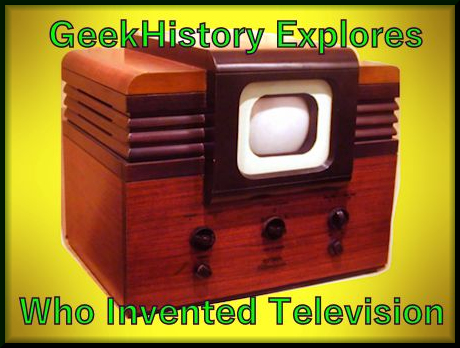 To answer the question, "Who invented Television?" given the choices of: Paul Gottlieb Nipkow, Vladimir Kosma Zworykin, Philo Taylor Farnsworth, or John Logie Baird, who would you choose?
To answer the question, "Who invented Television?" given the choices of: Paul Gottlieb Nipkow, Vladimir Kosma Zworykin, Philo Taylor Farnsworth, or John Logie Baird, who would you choose?
The answer could be any or all of the named individuals. It is impossible to attribute the "invention" of television to a single individual or corporation, nor can one say that it was "invented" in a given year. We are not trying to trick you with the answer, but simply make the point that with most great inventions it is difficult to give credit to a single individual for being the sole inventor.
Paul Gottlieb Nipkow
Paul Nipkow proposed and patented the first electromechanical television system in 1884. Paul Nipkow was the first person to discover television's scanning principle, in which the light intensities of small portions of an image are successively analyzed and transmitted .
No one is sure if Paul Nipkow actually built a working prototype of his television system. It would take the development of the amplification tube in 1907 before the Nipkow Disk could become practical. All mechanical television systems were outmoded in 1934 by electronic television systems.
Boris Lvovich Rosing
Russian scientist and inventor Boris Rosing expanded on the designs of Paul Nipkow and his mechanical system of rotating lenses and mirrors. Rosing recognized the shortcomings of mechanical television; he thought that the image should be displayed electrically on a cathode ray tube (CRT). By 1902, Rosing began actual experimentation to test his ideas, constructing a simple apparatus for electrically deflecting the beam of a cathode ray tube.
Rosing filed a patient in Russia in 1907 for a "Method for the electrical transmission of images over a distance." Rosing demonstrated his improved design for television in 1911. An article published in the June 17, 1911 of Scientific American, "Prof. Rozing's 'Electric Eye' — a new apparatus for television," documents the demonstration.
John Logie Baird
During the 1920's, John Logie Baird patented the idea of using arrays of transparent rods to transmit images for television. John Logie Baird was the first person to transmit moving silhouette images using a mechanical system based on Nipkow's disk.
On March 25, 1925, Baird held his first public demonstration of television at the London department store Selfridges on Oxford Street in London. In this demonstration, he had not yet obtained adequate half-tones in the moving pictures, and only silhouettes were visible.
Picture quality was very poor, and the screens were only an inch or so wide and were made up of only 30 to 60 lines (compared to 525 lines in the present U.S. system). These sets used a motor to rotate a metal disk to produce the picture, rather than a picture tube. A neon tube behind the disk provided the light. By 1930 it was clear that mechanical television systems could never produce the picture quality required for commercial success.
Electronic television requires a cathode ray tube (picture tube) to display the picture, and some sort of electronic camera tube to capture the image. The cathode ray tube was the easier of these to develop, but the emergence of electronic television was delayed for years until a suitable camera tube could be developed.
The Philo T. Farnsworth “vision”
Philo Farnsworth, a young man with no electronics background, proposed his TV system on the blackboard in chemistry class in 1922, when he was 15 years old. Farnsworth conceived the idea to produce pictures using his Image Dissector camera tube. Farnsworth's first application for a patent cover a complete electronic television system, including an "image dissector tube." was made January 7, 1927. The image dissector was used to scan the image for transmission.
Years later, his chemistry teacher redrew that sketch and helped Farnsworth win a long courtroom battle against the Radio Corporation of America (RCA).
Vladimir Zworykin develops television for RCA
Vladimir Zworykin was a pupil of Russian scientist and inventor Boris Rosing at the St. Petersburg Institute of Technology and assisted him in some of his laboratory work. With the outbreak of World War I, Russian born Vladimir Kosma Zworykin decided to leave Russia for the United States.
Zworykin found work with Westinghouse. Based on their pioneering efforts in radio, he tried to convince them to do research in television. In 1923, Zworykin demonstrated his system before officials at Westinghouse and applied for a patent.
In 1929, Zworykin invented the all electric camera tube. Zworykin called his tube the Iconoscope "a viewer of icons". He demonstrated both the iconoscope and kinescope to the Institute of Radio Engineers. The Iconoscope tube could produce good pictures with a reasonable amount of light. In attendance was David Sarnoff who hired Zworykin to develop his television system for RCA.
David Sarnoff, President of the RCA Victor company, realized the potential of television, and poured huge resources into its development, even during the lean years of the depression. RCA introduced electronic television to the U. S. at the 1939 World's Fair, and began regularly scheduled broadcasting at the same time.
In our next chapter we will go into more detail of the business and technology battle over the invention of television: Philo Farnsworth versus Sarnoff and Zworykin.
So who invented television?
The ancestors of Philo Farnsworth work to keep his legacy alive, pointing to his vision of a TV system that he created on the blackboard of his high school chemistry class in 1922. It is a nice story of Farnsworth as the small town inventor of television, but even if Farnworth's ideas were totally his own, his "invention" had already been demonstrated. Boris Rosing demonstrated a working model of cathode ray tube television in 1911.
Boris Rosing began experimentation with cathode ray tubes to project images in 1902. But Rosing's ideas expanded on the designs of Paul Nipkow and his mechanical system of rotating lenses and mirrors.
Often Vladimir Zworykin is called the father of television for his work with David Sarnoff developing television for RCA in the 1930s. Zworykin was a pupil of Boris Rosing who assisted Rosing in some of his laboratory work.
It is impossible to attribute the invention of television to a single individual nor can one say that it was invented in a given year. Very much like our answer to the question of "who invented radio?" we point to a very long evolution of ideas over a period of many years.
Image: Geek History graphic using photo of an RCA model TT-5.
The 5 inch screen television sold in 1939 for $199.
